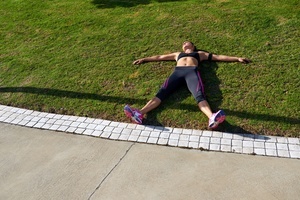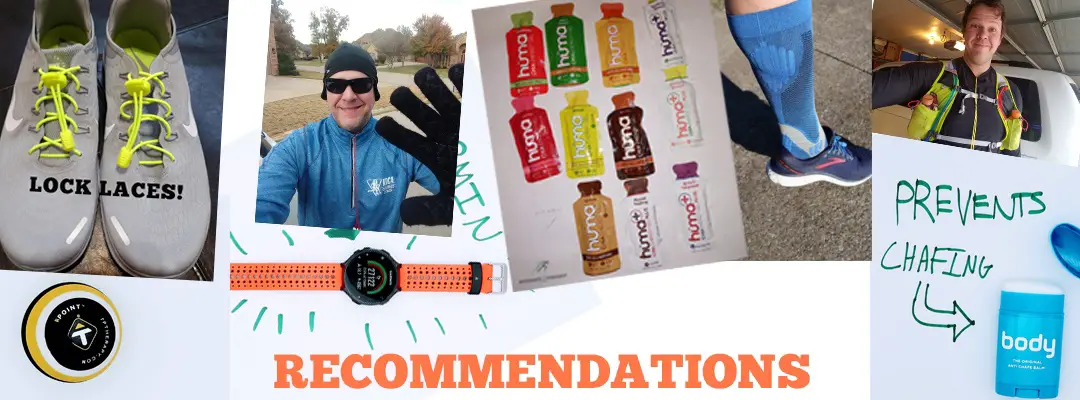The Long Run for Half Marathons
“How do I make my long run easier?” Is there an easy answer to this question? No. “If it was easy, everybody would do it.” That doesn’t help does it? So, why do beginner runners struggle with long runs during a half marathon training cycle? First and foremost, almost all new runners that are training for their first half marathon will struggle with long runs, some more than others. Most first-time long-distance runners go into training thinking that they have to perfectly run a designated amount of miles per their training schedule and not mess up on any long runs. Both are false assumptions. Of course, I’m not telling you to purposely flop your runs. I just want to layout a safety net in your thinking about long-distance running. There will be days that you feel like you can run forever and there will be days that you will be looking for that secret motivational pill that you just can’t seem to find.
What is a long run?
If you begin to struggle with your long runs, it’s important to remember why we have a weekly long run. The main reason we run long during training is to prepare our body and mind to go the distance of 13.1 miles. From a mental standpoint, it’s about knowing what it mentally feels like to be running for two hours plus. From a physical standpoint, your body needs to be able to store additional glycogen to fuel your body for the upper miles beyond miles 9 and 10. Your body also needs to simulate, before race day, what your body will feel like when you are on your feet for two hours or more. During a 12 week half marathon training schedule your body needs to run for at least 3 total long run sessions of at least a duration of 2 hours each session. A long run training session that calls for either a 9, 10, 11, 12-mile long run, will get you the minimum of the 3 times 2 hour long runs in before your race day.
The top three No-Nos to AVOID during your weekly long run training sessions:
1. Running too fast on your long run half marathon training sessions.
Long runs are not designed for you to go full speed. The purpose is to train your legs to run that distance. Your long runs need to be at a comfortable pace and anywhere from 2 to 3 minutes slower than your predicted training pace for a half marathon. If you don’t have a half marathon predicted pace yet, click here to sign up for a free training schedule, log sheet, and pace predictor.
2. Stopping altogether before you’ve reached your long-distance goal for the day.

For example, let’s say your training schedule calls for a long run of 9 miles for a given week. During your long run you break down and for whatever reason, you call it quits at the end of 7 miles instead of 9. Think twice about completely stopping in the middle of a run. Instead of not running the remainder of the 2 miles just simply walk the rest of the way. Although you’re not fully training your legs to run the last two miles of your long run, you will still be upright and on your feet pushing to complete your 9 miles. This is important! One thing to be wary of is if you keep repeating the above same scenario. If you find yourself giving up before your long run distance is complete, then you might want to pull back to an even slower pace for your long runs.
I have witnessed firsthand from running seven different half marathon races and watching the last runners cross the line that there are tons of runners that end up walking the last couple of miles. THERE IS NOTHING WRONG WITH THIS, especially if this is your first half marathon. The main goal for a new half-marathoner should be to finish the race.
3. Not Experimenting with your long run fueling strategy.
Remember that long-run training sessions are the time to experiment with your fueling. Also, you need to find out what pre-run meal works best for your body. On your actual race day, it’s the wrong time to experiment. You should be eating the same pre-run meal and using the same fueling strategy that worked for you during your training sessions. Click Here for my half marathon fueling strategy.
How do I make my long runs easier?
In essence, your long runs shouldn’t be your easiest runs. Nor should your long runs be your hardest. The only way to make your long runs easier is to run more. By increasing the volume of your runs throughout the week, you build a stronger more fit aerobic base on which your long runs require. The equation looks like this:
Easier long runs = time + increased weekly volume of base miles
Sorry, there are no shortcuts in the long run. Again your long runs shouldn’t be difficult and they shouldn’t be easy. You simply need to complete your long runs at a slower pace than your half marathon/marathon race pace. The decrease in pace can be anywhere from 30 seconds (advanced runners) to 2 minutes slower than your half marathon/marathon pace. Elite runners can probably knock this down to only 10-15 seconds slower. If you want to know more about base miles click here.
Long Run Habits
We all know what a routine is. Getting up in the morning consists of fairly identical tasks you perform every day. Of course, there will always be slight variations in your morning, but for the most part, it’s consistent. In order to successfully complete a half marathon or other long-distance training goal, you have to create a new habit and have a checks and balances system to make sure you stay on top of the habit. To get your new training habit off on the right foot, we need to look at three things that can help you during your long run sessions. Changing how you think of exercise, having a good support system, and having a check and balances system will help you stay on track to crush your long-distance goals.
You No Longer Exercise – You Train!
To simply complete a 5K or 10K race, it requires little or no training at all. When you switch to half marathon races and beyond simply throwing on your running shoes and running 3 miles a day won’t cut it. Some of you might be wincing a little bit, but hear me out. What you read and what you think and how you process all the data that gets absorbed by your brain every day determines your outcome. You know the old saying, “you are what you eat,” well this is exactly the point. Changing your thought process from exercising to training is a simple but powerful concept. When you exercise you are primarily worried about the outcome of one session. When you exchange exercise for training you are then concerned with not only the current run session but your overall goal. That goal is to complete your training for some type of long-distance race such as a half marathon. By using the word training, you’re subconsciously telling yourself your running habit is for a much bigger goal. This helps bring your mind and perspective to a whole new level.
Long Run Support System
Training with a buddy or a running club can help support you during those times when you’re not feeling like training. Training partners are great to help you get unstuck and moving when your legs feel like cement. A running club is also another great way to power through your lazy woes that may come about. If one member of the running club isn’t helping with your motivation then you can hopefully find another member that can help. You can always get support through social media if you feel like you need a boost of motivation. Although partners and social media are great to give you that extra kick to get going, you shouldn’t always rely on other people for all of your motivation. You need to create a backup system so that you can push through longer runs with or without a partner. Creating an affirmation or mantra can help boost your motivation and put you in the correct frame of mind to accomplish your running goal for the day. This not only applies to running but to other aspects of your life. Here are a few that I have used while training:
- I’m a runner
- I’m training for a half marathon
- Focus on the goal
- Just one more mile
- I will complete my training today
- I won’t quit, I won’t stop
You can use any variety of these or create your own. Also, having a playlist of music with your favorite songs to listen to while running can also help give you an extra boost when you’re thinking about cutting your long runs short.
Checks and Balances
A training schedule is an essential road map to get you to the half marathon finish line. Keeping yourself accountable to your weekly training sessions requires dedication and resilience. A training schedule is only half of the solution. Keep a daily training log of your weekly runs in the second half of the solution. Your training schedule and running log together create a checks and balances system. Utilizing both together will help keep your running habits focused and aligned with your ultimate goal to finish a race. There are tons of smartphone apps that can help keep track of your runs. I prefer to physically write them down on a log sheet.
Long Run Strategy For Beginners
So, if you’re wanting to walk or run a half marathon you will need to tie all of these habits together. Here is a list of the things that you need to get ironed out before you begin your training:
- Select a training plan (these range from 8 weeks to 20 weeks depending on your fitness level).
- Select a race date.
- Lock in your first day of training so you’re ready to start.
- Create affirmations or mantras (above).
- Check your training requirements for the week and then for the day (habit-forming).
- Begin your first day of training (habit-forming).
- Log your run as soon as you’re done with your running session (habit-forming).
- Repeat Steps 5-7 until you finish your race. (habit-forming)
- reflect on your log and training schedule at a minimum weekly to see if you’re still on track.
- If something comes up and you can’t make a run then try to make it up. Your long run sessions are the training items that are the most important for long-distance running. Try at all costs to make them up in full (or close to the mileage).
Having a running routine is essential to help you stay on track to finish a half marathon training cycle. Running, eating, rest, and recovery all have to do with your daily and weekly routines. If anyone of them is off it will affect the other moving parts of your running routine.
Related: How To Make Running A Habit For Life!
Changing Up Your Geography Can Help Long Run Struggles
If you run the same location every time you go for a run, try to change things up by changing your geography. Running the same route at the same time does have its benefits. One reason we run the same route every time is for familiarity and safety. For some runners, this is a must, and if you are that type of runner, I won’t try to pry you away from your routine.
Science has shown that changing up a routine habit can cause your neural pathways to expand and grow in different directions. For instance, if you normally run in your neighborhood, instead you could find a local park that has a trail that matches the length of run your training demands. For instance, if your routine is to run in the park, maybe you can run on a track. If you live by a beach you could run on the sand. If you’re lucky enough to live in the mountains, you can participate in trail running.
New Terrain Works New Muscles
By changing up the geography, you’re changing up your physical and mental state by adding new surroundings and stimuli. Your physical body will also experience a change in location due to the change in the terrain. By changing up the routine, you’re helping your body release from the exact routine which can cause different muscles to work that normally don’t get used in your “go-to” routine run locations.
With the modern smartphone, it’s now possible to just start running in any direction with little preparation. When you are done running, you can call someone and give them a waypoint via your smartphone to come to pick you up based on a GPS location. Or you can just have Lyft or Uber pick up for a fee and take you back to your starting location.
The one drawback to this type of running is that at the end of running you are usually doused in sweat, and the driver might not appreciate you getting in the car after you ran 10 miles.
Try a circuit or loopback run
You can also try running in a circuit or loopback where you run half the distance from your current start point and then when you reach the halfway point you run back to your starting point. I used this technique for all my long runs which led up to my first half marathon race.
If you want to change up the location where you run, you can add an environmental factor in such as running in the rain or snow. I honestly don’t suggest running in either but some people, depending on where they reside, have no other choice.
I have run both in the rain and snow, and both require more gear. This gear for your feet consists of booties to help keep your feet dry. The gear for your body consists of a light dry shell or extra-thin layers of clothing to keep you warm. Sometimes a run in either of these conditions can help you appreciate running in a much more pleasant environment.
When you run shorter distances such as a 5K, your biomechanical running form is not going to create any type of “form drag” on your performance. Also, I’m not advocating that you go out and purposefully try to change your striking technique or your overall form. However, your running form could be causing you to deplete more energy or let your body become more susceptible to running injury thus causing you and your long runs to suffer.
By analyzing the foot strike, proper form, and extra luggage such as water bottles and phones, you might be able to help your legs stay safe and conserve a little bit more energy for your longer runs.
Long Run Foot Strike
First of all, study after study after study has been done and there is no evidence to support that one type of foot strike causes more injury than the other. The causes of injury are actually due to where the feet land in perspective to the body. If you are a sprinter then you will be using forefoot striking.
Three types of foot strikes:
Forefoot – the forefoot and toes land first on each step.
Midfoot – the midsole lands first.
Heel – the heel of the foot lands first. This is where the majority of runners fall into place. About 75% – 85% of all runners are heel strikers. This statistics depends on what source you reference or who you talk to. I myself am a heel striker.
Overstriding
What you want to avoid is continuous overstriding during the long run. The forefoot strikers are prone to overstriding. Olympic sprinters land on the forefoot and their feet land out in front with each stride. The sprinters are purposefully doing this for speed. As long-distance endurance runners, you want to avoid overstriding. Your foot should land slightly in front and below your hip.
Long Run Running Form
First of all, no running form is perfect, however, there are some basic guidelines you should follow. Again, I’m not trying to get you to change your form. I’m simply trying to make you aware of ways that your energy might be draining out of you quicker than it should.
- Your Arms should be close to the side with a nice easy swing on each stride. Your arms don’t need to extend beyond a 90-degree hinge.
- The spine is straight.
- The body leaned slightly forward.
- The shoulders should be relaxed and slightly pushed back.
- Your nose should be the most forward appendage on your body.
Some possible running forms that might be draining your body or causing possible long-term injury, especially during longer runs where the miles and iterations of your form amplify:
Running tense
This could be your shoulders or more commonly your arms. Some runners run with their arms tucked in and tightly toward their chest. By not allowing the arms to swing more freely your body is having to exert more energy for your muscles to hold your arms in place.
An Example of this is what I call the football blocker where the arms are tucked in and parallel with the chest and it looks like they are blocking with every stride. If you run like this, again, I’m not telling you to change, just be aware that contracting the muscles like that requires more energy than an easy normal forward swing of the arm.
Bouncing while you run
Unless you’re running a specific drill such as knee hikes or runner hikes, you should avoid bouncing. Some runners don’t know that they bounce. If you have a feeling that you might bounce when you run you need to have someone videotape you for a minute or two running.
When you bounce mile after mile on long runs, your body is springing up at a higher distance from the ground and coming down with more force on impact. This repetition over and over again causes more energy exertion and the possibility of injury.
Extra Baggage During a Long Run
Your extra baggage could be causing an imbalance with your running gait cycle. If you run with a phone especially over long distances (5+ miles) try to wear the armband on the upper part of your bicep and not down along the forearm.
Even though a phone doesn’t weigh that much, mile after mile can add up and one side of your body might be slightly overcompensating for the difference in weight. Also, make sure you’re switching your phone placement between different arms every other run.
Phone Placement
 If you hold your phone in your hand, make sure to switch hands every mile or every 5 minutes or so. The same goes for a handheld running water bottle. For more information on running with a smartphone click here.
If you hold your phone in your hand, make sure to switch hands every mile or every 5 minutes or so. The same goes for a handheld running water bottle. For more information on running with a smartphone click here.
Hydration belts worn at the waist might be the best place to store your extra baggage. Some belts even have room for your phone to sit on your upper tailbone. A hydration belt is a good solution because it is worn on a part of the body that doesn’t have much movement while you’re running. If you do wear a belt, make sure you try to evenly distribute the weight across the belt.
A hydration pack is probably one of the best ways to carry your water and even your phone. It sits on your back and it’s securely fastened to your body with minimal movement. The weight is evenly distributed across the back and you don’t have an imbalance.
Get More Out of Your Long Runs
Long runs are not just for building and expanding your glycogen stores so that you can finish the half marathon race. Here are 5 more ways to get more out of your long run half marathon training sessions.
How to prepare for a long run
The long-run is arguably the most important run when your training for greater distances such a half marathon or marathon. Make sure that you’re taking correct preparation so that you complete them without a hitch. I created an 18 steps checklist of what you need to do to prepare for your long run. Check out the post here: How to prepare for a long run: 18 steps to make your long runs successful!
Long Run Conclusion
Most of these techniques and forms don’t really become prevalent until you’re out on the road running 5+ miles. One of the best ways to help you when you begin to struggle when you’re running is remembering your running form and your breathing. Your breath should be deep and through your nose and mouth.
If you find yourself breathing quickly, shallowly, or just out of breath, then you need to slow down, maybe even walk for a minute or two to readjust your breathing.
If you’re suffering from a lack of motivation try running with someone slower.
Related: What Is LSR In Running? Can It Improve My Running?
| Help support me and subscribe to my YouTube channel. YouTube video - 30 ways to make your runs less painful! Coach Scott's Credentials:
|
To sign up for a FREE half marathon training schedule, log sheet, and pace predictor CLICK HERE.

Recommended gear for runners
Connect with me:
| facebook.com/BeginnerToFinisher/ |






